This Chrism Mass is one of the great liturgies in the first half of Holy Week. Each Tuesday of Holy Week, Cardinal Sean gathers with several hundred priests from the Archdiocese of Boston and various priests of local religious orders to celebrate the Chrism Mass. His homily is typically one of Cardinal Sean’s significant annual messages to priests.
During this Year of Faith, Cardinal Sean challenged priests to be holy men of faith. He also reflected on the recent events of the Conclave and how they are analogous in some ways to the beginning of the implementation of the Pastoral Plan, Disciples in Mission.
One of the new things at today’s Chrism Mass, as compared to others I’ve attended in the past decade, are that many Catholic schools and their students/faculty are in attendance. It’s clear that many of the students are visiting the Cathedral for the very first time. It’s been wonderful to see how wide their eyes are when they enter this beautiful house of God. Â One of the schools in attendance is The Boston Archdiocesan Choir School at St. Paul’s Church in Cambridge, which is joining the Cathedral Festival Choir to lead the congregation in worship music.
Below, hear the choir sing the Ave Verum Corpus:
One of the highlights of attending the Chrism Mass for me is to see the joy and happiness of our priests when the gather as a group. For priests, the Chrism Mass is like an annual reunion. After Mass, they also gather for lunch and honor 2 of their brothers for their inspirational service to the people of God in the Archdiocese of Boston.
Here is a link to the Mass program.
All the beautiful photos in this blog post are from my colleague, George Martell.
Homily of Cardinal Seán O’Malley, OFM Cap
Archbishop of Boston
Cathedral of the Holy Cross
Chrism Mass – March 26, 2013
I was very sorry to miss St. Patrick’s Day last week here in Boston. I did manage to get to the Pontifical Irish College in Rome for a great meal with the Irish community there. No corned beef, our normal Seder meal here in Boston. The food, though, was green, orange and white.
The whole pre-Conclave atmosphere where I was leading in the Italian polls was quite surrealistic. I thought of St. Patrick who was of a Roman family living in Britain. Patrick was an Irish wanabee, he was actually an Italian kidnapped by Irish pirates. I was worried that the Italians were trying to get even. Actually, I was very touched by the Italian people’s enthusiasm for your Archbishop.
Needless to say, I am very happy and relieved to be back home in Boston. The whole experience of the Conclave was extraordinary. I felt very close to all of you. I knew that we were united in prayer, praying that the Holy Spirit guide our Church in this important decision. Like the first Christians praying intensely before choosing St. Matthias to be an apostle, to fill the vacancy and to pass on the office of Apostle.
We were all delighted that, for the first time in history, the Ecumenical Patriarch of Constantinople was present for the inaugural Mass. Patriarch Bartholomew has even invited Pope Francis to come with him to the Holy Land to mark the 50th anniversary of the historic visit of Pope Paul VI and the Patriarch Athanagoras. By the same token, the presence of His Eminence Metropolitan Methodios here today is one more sign of the growing hope for our Churches to be reunited.
One of my favorite books in the New Testament is St. Luke’s Acts of the Apostles, which has been called the Gospel of the Spirit.  Acts highlights the ministries of Saint Peter and Saint Paul but the real protagonists of this book are the Holy Spirit and the community of faith. It is a book of frenetic action amid a constantly shifting scene: Conspiracy and intrigue and ambush; hostile confrontations and fierce conflicts, rioting lynch mobs and incessant missionary journeys all over the Mediterranean world, complete with shipwrecks and venomous serpents, chains and imprisonments and at least two successful prison breaks; famine and earthquake; crime and punishment; and powerful sermons, all guided by the Holy Spirit who was poured out on those first Christians at Pentecost.
In our Greek classes, the old German friar who taught us stressed how St. Luke used classical literary forms and the most elevated style for the Acts of the Apostles, but that the way Acts ends so abruptly is quite a departure from the literary construction of the rest of the book. Â There are several plausible explanations:Â Luke may have died, leaving the work unfinished; Amazon may have cancelled his contract, or, as I like to believe, he meant that the Acts of the Apostles never really ended, that now we are the new cast of characters and the Holy Spirit is leading us in these turbulent times.
Certainly for me the Conclave was a Pentecost experience right out of the Acts of the Apostles. Catholics all over the world were praying for the Church, the Cardinals and for the Conclave, so that the Holy Spirit would guide us. I have no doubt that all our prayers were answered. In the Gospels, Jesus is always seeking those at the periphery and bringing them center stage. By having a Pope from the Southern Hemisphere the Church is doing that. The strongest growth and vitality among our over one billion Catholics in the world is in the South Hemisphere. I am sure that Pope Francis will be a great stimulus and an encouragement to our brothers and sisters in those parts of the world. Soon half the Catholics in our own country as well will be Hispanics as well.
I am also convinced that Pope Francis’ unswerving devotion to the poor and the social Gospel of the Church will also touch the hearts of many in the secularized countries of Europe and North America and help them to see the Church in a new light.
Here in Boston, we must see ourselves as the continuation of the Church of the Acts of the Apostles, with so many dramatic challenges, we must cultivate a deep trust in the abiding presence of the Holy Spirit to guide and unite us.
As we work to implement the Pastoral Plan, it cannot be just about strategy or techniques, but about our own deep awareness of God’s loving presence in our Church. All of our discussions and planning, like the work of the pre-Conclave Congregations and the Conclave itself, needs to take place in that atmosphere of prayer and trust in God’s love for us.
Likewise here in the Archdiocese our thrust toward the New Evangelization and the pastoral plan, Disciples in Mission, must be realized in an atmosphere of prayer and discernment and with a profound trust in the presence of the Spirit to guide the Church. The Spirit acts where there is prayer and unity, and the Spirit enables us to pray and to overcome all of our differences so that like at Pentecost, we can all hear the wonderful things of God, each in his or her own language.
I am so grateful to all the Pastors of the parishes of Phase One, who with great faith and generosity, have entered into the planning process, making sacrifices for the sake of the greater good.
As my brother Cardinals and I entered the Conclave, we did not know what the outcome would be or what the future would hold. We were called to make ourselves available for the mission of the Church. Our pastors in the first phase of pastoral planning have likewise been called to make themselves available for mission, without knowing what the outcome would be as once again they responded, “adsumâ€. The Archdiocese is greatly blessed by their dedication, commitment and example of selfless service as we embark on the journey of rebuilding our parishes and welcoming the faithful back to active participation in the life of our Church. We want our Pastoral Planning, like the Conclave in Rome, to be a Pentecost moment in this Year of Faith.
In this context, I would like to reflect for a moment on the Catholic priest as a man of faith. Today we come together as a presbyterate who have a special connection to Christ and to one another.
Pope Benedict, our Pope Emeritus and an extraordinary teacher of the faith, has given us this Year of Faith. Pope Benedict always relates faith and joy. The deeper our faith the more we will experience the joy of being Christ’s disciple and friend. Pope Paul VI used to say that more than teachers the world needs witnesses. The Church needs us to be joyful teachers and witnesses of the Catholic faith. The fact that the Year of Faith marks the anniversary of two great events: The Second Vatican Council and the publication of the Catechism, underscores the importance of the content of faith. It is of great importance that we be able to understand the rich teachings of Second Vatican Council in the context on an hermeneutic of continuity that can help the Church teach the Gospel to the contemporary world without being cut off from the tap root of tradition. The Catechism is also a very valuable tool to teach the doctrines of the faith and demonstrate how they are interrelated, and to present a coherent vision that forms a pattern for a way of life.
Understanding the content of the faith is important in order to have the vision that allows us to lead a life of faithful discipleship.  The priest as a man of faith must be a student. Our ongoing formation is a crucial aspect of our priestly life. There is a direct correlation between neglecting ongoing formation and pastoral burn out. Our ability to preach with confidence and enthusiasm, our capacity to help our people understand complex ethical issues, our creativity in organizing the pastoral life of our parishes, our appreciation for the liturgy and its execution are all affected by our commitment to ongoing formation or the lack of it.
Once again, the success of our pastoral planning is conditioned by our commitment as priests to our ongoing formation. We cannot tell ourselves or each other that we do not have time.  Neglecting our ongoing formation will cause great detriment to the pastoral life of our Church and to our life and to our own lives as priests and ministers.
In the first instance, for a priest to be a man of faith means that Christ is the priest’s best friend. In the Gospels, the Greeks go to the Apostles and say, “We want to see Jesusâ€. Our people want to see Jesus in us; they want to know that Jesus is our best friend. In our compassion, understanding and self-sacrifice, in our lives of obedience, of chastity, and of generosity, they want to glimpse the Good Shepherd who has laid down their life for them.
To be such a man of faith means having a real interior life. Prayer, reflection on the Scriptures, and an annual retreat that is a serious time of introspection are all essential for our life and ministry. It also means acts of penance, making sacrifices out of love for God and a desire to make reparations for our own sins. It means making use of the Sacrament of Reconciliation as a means of ongoing personal conversion.
Our friendship with Christ in inexorably bound to our vocation to be men of the Eucharist. Archbishop Sartain wrote a very moving letter to his priests urging them to say Mass each day. He says, “as a husband kisses his wife with affection each morning, so a priest should kiss the altar every day.â€Â This is a very public gesture made in the presence of those gathered for the Eucharist; but it is at the same time an intensely private gesture, an act of affection and surrender, an act of love and trust. Even more to the point, the priest’s kissing the altar is an act of identification: he is proclaiming to Christ, to himself and to his parishioners that it is Christ the High Priest who makes him who he is. We kiss the altar as a sign of the Lord himself, the sacrifice of Calvary, and the table of the Last Supper. Everything we do flows from the altar and back to it. The kiss symbolizes our daily embrace of the sacrifice of Christ as our way of life, for on the day of our ordination, we were totally and irrevocably joined to Christ our High Priest.
In the Latin rite we begin the Eucharist by kissing the altar; at the end of every celebration of the Eucharist, Maronite priests pray a beautiful prayer that is a farewell to the altar. They pray:
“Remain in peace, O holy altar of God, I hope to return to you in peace. May the offering I have received from you forgive my sins and prepare me to stand blameless before the throne of Christ. I know not whether I will be able to return to you again to offer sacrifice. Guard me O Lord, and protect your holy Church, that she may be the way to salvation and the light of the world.â€
I was once at the funeral of a Maronite priest. His brother priests carried his body around the altar, reciting this prayer of farewell to the altar. It is a very moving sight, and a reminder to celebrate each Mass as if it were our last Mass.
As priests, our love for the Mass and Eucharistic devotion are what nurture our friendship with Christ and our priestly identity as men of faith and best friends with Christ.
The priest as a man of faith is to be a teacher of the faith. There is so much religious illiteracy in today’s world. Our service as preachers and teachers of the Catholic faith is crucial for the life of the Church. In today’s secularized culture, we must prepare ourselves to be able to explain the faith. The book I sent you at Christmas, How to Defend the Faith Without Raising Your Voice: Civil Responses to Catholic Hot Button Issues, is a wonderful primer on a new way to broach the difficult topics that confront us and at time cause people to become estranged from the Church. In our parishes we are head catechists, and need to prepare and encourage those who help us in the responsibility of teaching the faith.
We must know that the questions left unanswered can lead to doubts. Our people do have a desire to know the faith and to understand the Eucharist.  I often comment on how our young couples attending the marriage preparation programs have consistently said that their favorite part of the weekend was “the teaching Massâ€. An important part of the New Evangelization is teaching the faith. For us, that begins with the Sunday experience. We must make the Sunday Eucharist central in our efforts to grow our parishes. In his book, “Rebuilt” Fr. Michael White describes his frustrating efforts to revitalize Nativity parish in Baltimore, where all of the surveys revealed what the parishioners liked most was that it had great parking.
Fr. White tried a hundred different programs, greatly overburdening himself and his staff, with very little results. He finally became very angry, later describing this his “Popeye moment.†That allowed him to break out of the doldrums. His cry became, “It’s the weekend, stupidâ€, and he began to concentrate on the Sunday liturgy, the music, the children’s liturgy, and the preaching, and then things really began to turn around. The Eucharist is our best resource to teach the faith and build a community. If the Eucharist is the core of our own identity we will be able to kindle the Eucharistic amazement in the hearts of our people.
The priest is a man of faith when he witnesses to the faith. Our new Holy Father, Pope Francis, has underscored for us the Church’s preferential option for the poor. The priest must be a father to his people, but in a very special way, a father to the poor.
In Victor Hugo’s Les Miserable, the old bishop, Msgr. Bienvenue, refuses to denounce Jean Valjean who had just abused the his hospitality by stealing the Bishop’s silver candle sticks. When the police drag Jean Valjean back to the Bishop’s house, the old bishop rather than denounce the thief, gives the convict the rest of his silver. That act of mercy causes a conversion in the hardened convict’s heart.   In the film “Ryan’s Daughter,†the pastor in the Irish village is the constant companion of a mentally retarded man treated as the village idiot. The same pastor bravely protects a woman accused of collaborating with the enemy for falling in love with a British officer.
But we don’t have to turn to the world of art to see in our priests God’s love for the poor. It was a great moment for all of us on that Monday morning last December when the front page of the Boston Globe featured one of our own priests, Fr. Doc Conway, a Catholic priest reaching out to the people entrusted to his care. In our inner cities, in our neighborhoods, in our suburban communities where families’ lives have been upended by the protracted recession, in outreach to missions to Haiti and throughout the world, and responding to the homeless and the hungry at our doors, every day the priests of the Archdiocese of Boston witness Christ’s presence to people in need.
Our love for the poor is never just philanthropy, it is rather the Evangelical Poverty that inspired St. Francis to kiss the leper, to give all his wealth to the poor, to see Lady Poverty as freedom from the shackles of wealth. In the context of faith, embracing the spirit of poverty is an expression of humility, seeking the last place at table in order to be near to Christ who has come to wash our feet. As priests we are called to a simplicity of lifestyle that allows us to be free, unencumbered by expensive toys and hobbies. We are called to the detachment that allows us to recognize the poor and the suffering as an icon of the crucified Lord, as a manifestation of His presence in the world.
I am confident that Pope Francis’ love for the poor and his passion for the social Gospel will help galvanize the Church to a greater fidelity to the Gospel and a renewed commitment to building a civilization of love.
In the mission statements of our collaboratives and parishes, we must show our living faith by our commitment to serve the poor, the sick, the imprisoned, the immigrant and the stranger. St. James tells us, “Faith without works is dead.â€Â (James 2:20) The priest as teacher of the faith and father of the poor, must show our people that the Eucharist is the source of our strength for our mission. Our service to the poor must be humble, not self-congratulatory. It must be the normal outgrowth and expression of a faith community.
We do these works of mercy, caring for the poor and needy, because we are Catholics and it is what we are supposed to do. I often reflect on the occasion in the Gospel when Jesus takes his disciples to the temple to point out to them that poor widow who drops her last penny in the collection basket. Jesus doesn’t say anything to the woman, he doesn’t give her the money back. He simply wants his disciples to see and appreciate the faith and generosity of the poor widow.
Once as a young priest I was unvesting in the sacristy after Mass when a young Bolivian lad came in and handed me a hundred dollar bill. This is the first time this happened in that parish. I said, “What is this?†and he explained that he had found it in the parking lot. I was surprised that anyone who would have been in that lot would have had a hundred dollar bill. I knew the boy and his family. I had just recently baptized his little sister Shirley who had Down Syndrome. Their father had recently abandoned the mother and five children who were undocumented immigrants and were living in deplorable conditions. I went and spoke with the mom, Anita, who was waiting with the other children. I said, “Anita, do you have any money?†She said, “No, Fatherâ€, and then, “actually I had five dollars I was going to use to buy food, but then I heard today’s Gospel about the widow’s mite. So, I decided to put it in the collection.â€Â I gave Anita the $100 bill and said, “I think God wants you to have this. If anyone shows up looking for their hundred dollars, I’ll take care of it.â€Â Needless to say, no one ever came.
So many good people in our midst, in our parishes and in our communities, live hand to mouth. Many people who but a few years ago never thought they would be faced with shortfalls in providing the basic needs for their families, including many living in the leafy suburbs, are on the verge of insolvency following years of unemployment and discouragement. We are called to grow in our awareness of our brothers and sisters needs and determine how we, as a faith community, can help them. The little ones and those in need are the protagonists of the Good Shepherd’s Gospel of Mercy.
Finally, the priest is a man of faith in a community of faith that is built on relationships. First and foremost is our relationship with Christ, which is both friendship and of a sacramental character. Our priesthood also connects us with each other. The very ordination rite ritualizes the bond that unites us as priests. After the Bishop imposes hands on the ordinand, all the priests present come forward to impose hands and likewise the priests come forward to extend the greeting of peace to the newly ordained. This was done for each of us, and each of us has done this for other priests. Likewise, the vow of respect and obedience binds the priest not only to the Bishop but also binds him through the Bishop to his fellow priests. Today, in the Chrism Mass, we are united in the blessing of the oils that become our tools in our shared administration of the sacraments.
The task of evangelization is advanced by or unity or hindered by the lack of it. As we renew our priestly promises today, let us ask the Good Shepherd to make us one in our priesthood. Let us be joined in an intentional presbyterate that will allow us to be of one heart and one mind as we strive together to be men of faith, priests of Jesus Christ.
May Mary, the Mother of the Divine Shepherd, help us all to be priests after Christ’s own heart and give us a very special love for the poor, the suffering, the sinner, the outcast, the forgotten. May they see in us a father, a brother, a Catholic priest.
Immediately after the Mass, priests head to the lower level of the Cathedral to remove their Chasubles, Albs and Stoles and also to receive sacred oils for their parish.
After receiving the sacred oils, priests head across Union Park Street to the Cathedral High School gymnasium for lunch. Each year, the Archdiocese honors 2 priests. This year’s honorees are Fr. Arnold Coletti from Lexington and Fr. John Sheridan from Salem (who will be moving to Middleborough, Rochester and Lakeville in June). They are both revered by fellow priests. Each have also been very active at the work of pastoral planning over the past several years.
While the luncheon was taking place, Fr. Bill Kelly (pastor of St. Mary Parish in Dedham) and Fr. Joe Scorzello (from the faculty of St. John Seminary) joined Fr. Chris O’Connor and me to record The Good Catholic Life radio program. We discussed why the Chrism Mass is a special experience for priests and also reflected on Cardinal Sean’s message in his homily.

Full photos from the Chrism Mass are available at www.BostonCatholicPhotos.com.
Video of the Mass from CatholicTV is available at http://www.catholictv.com/videos/videos.aspx?videoID=148.


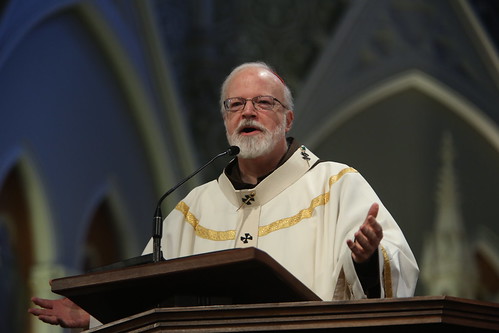
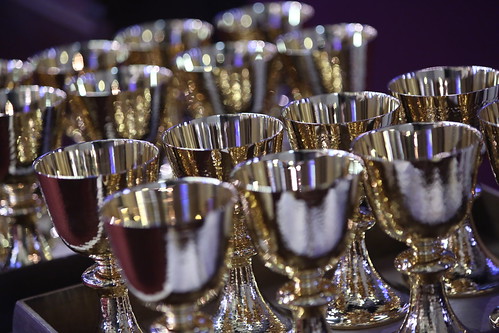
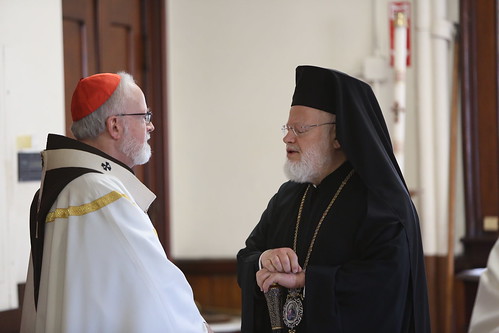
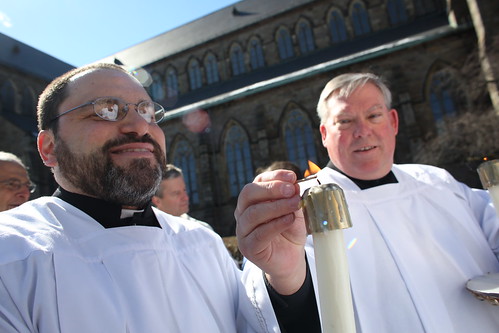
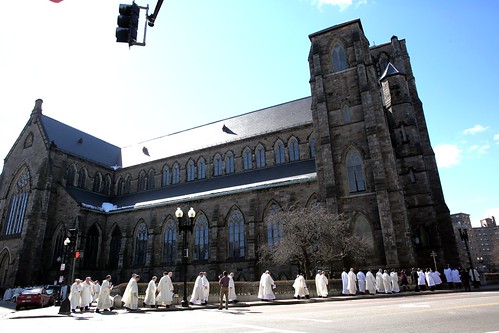
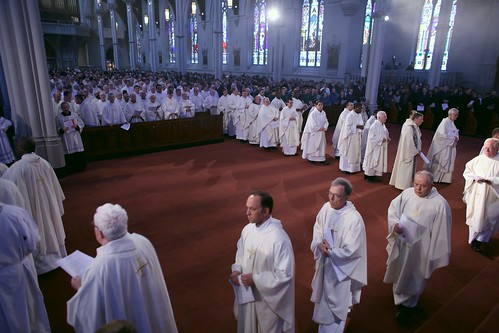
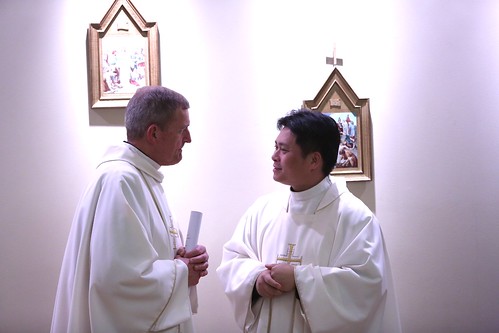
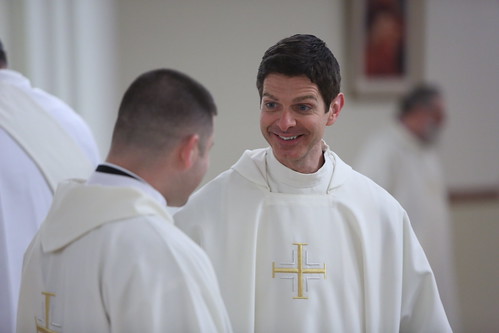
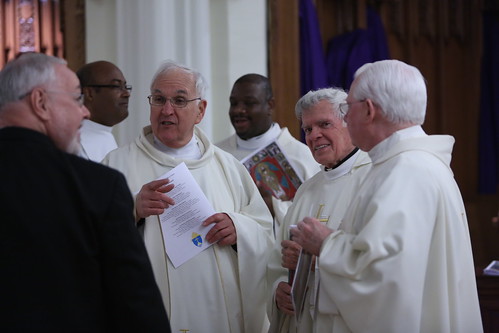


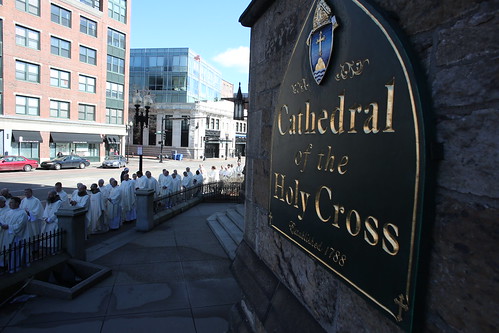
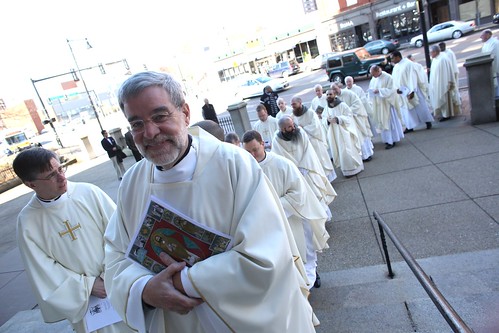
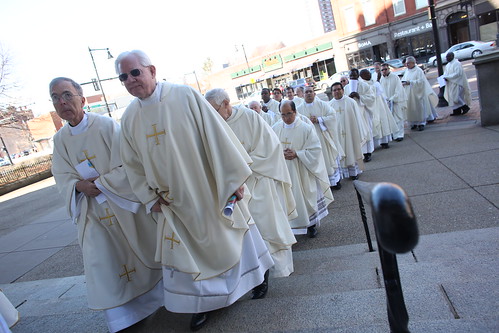
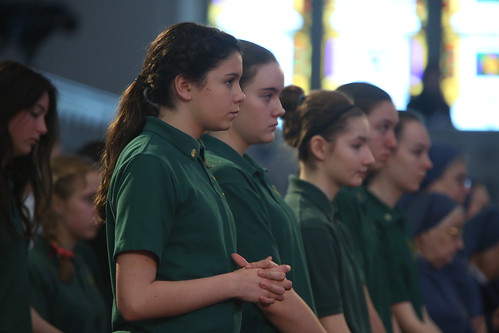

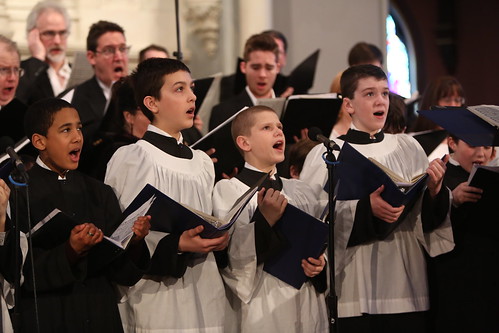

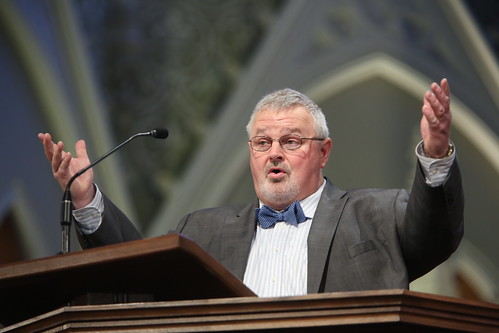
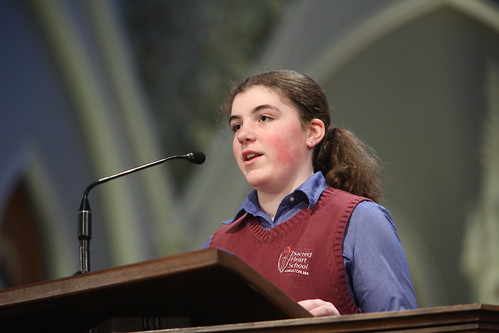
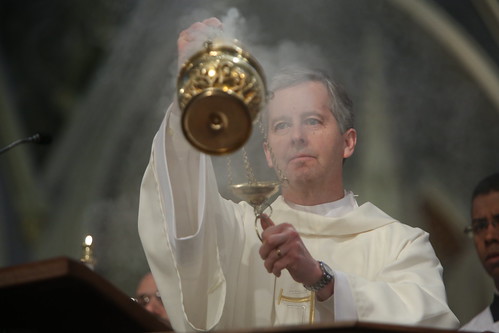

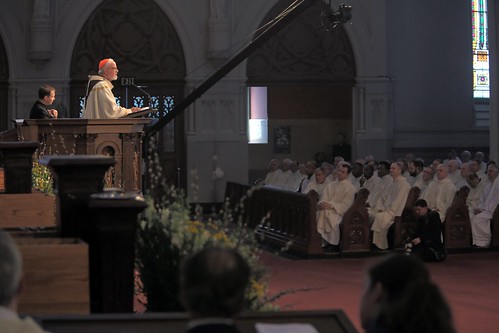
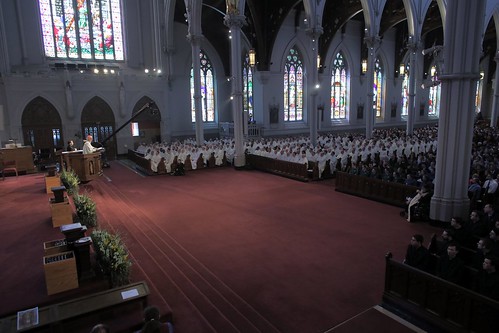

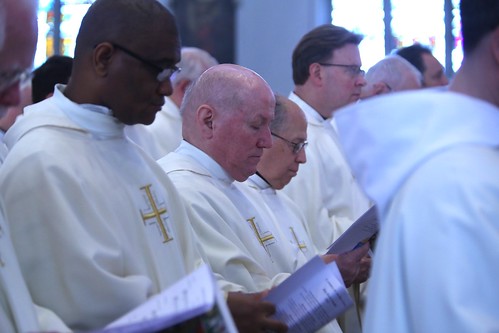
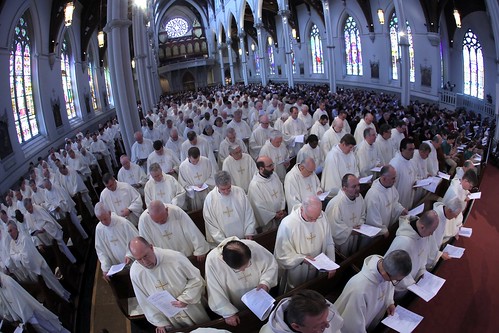
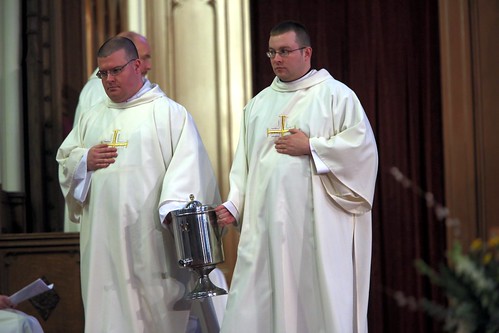
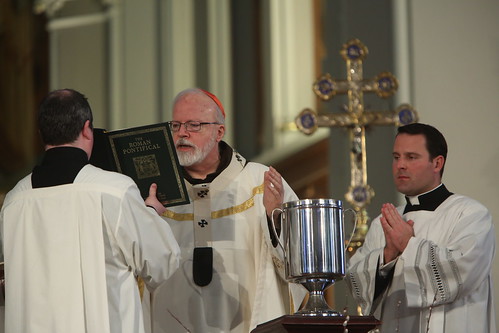
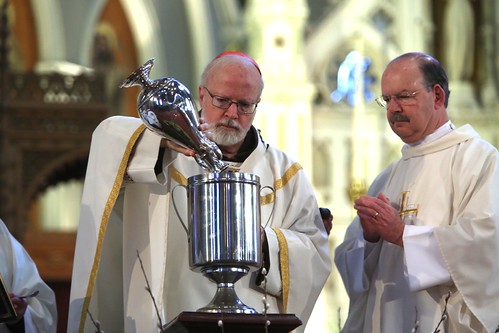
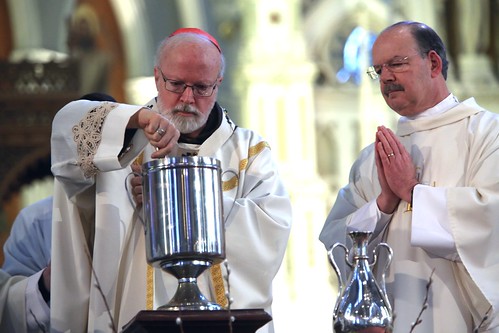

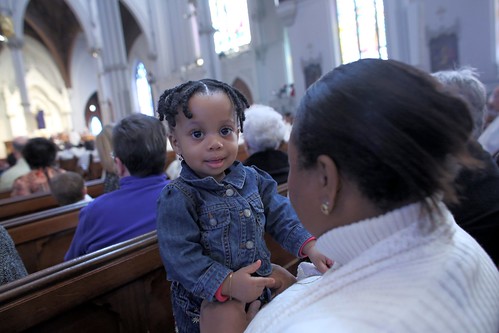
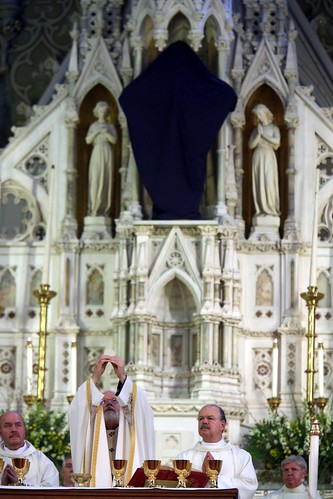
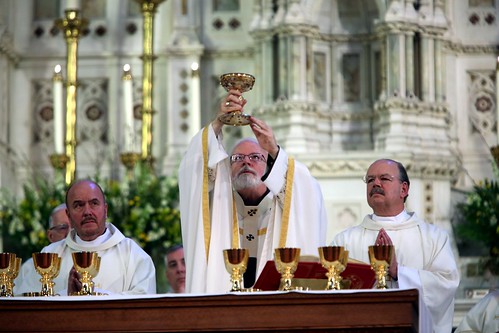
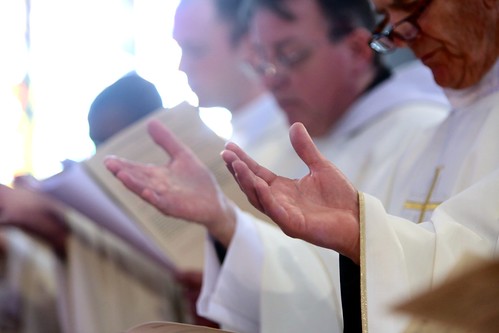
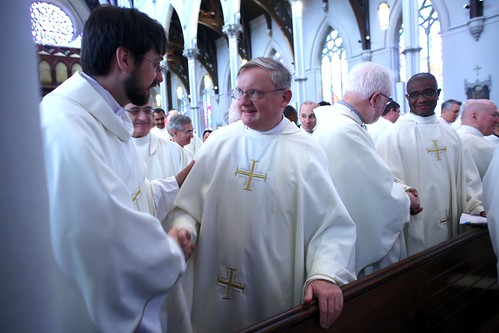

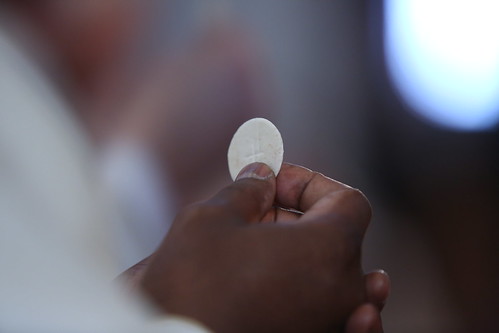
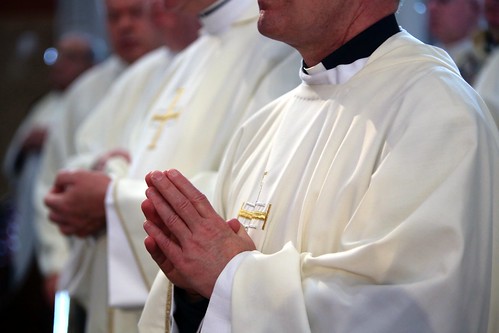
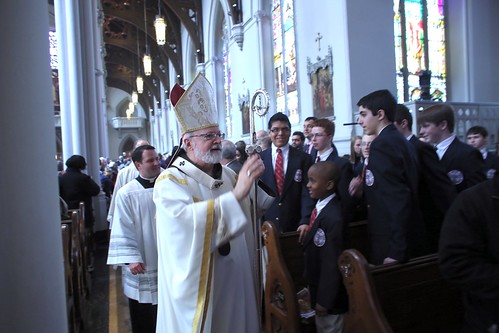

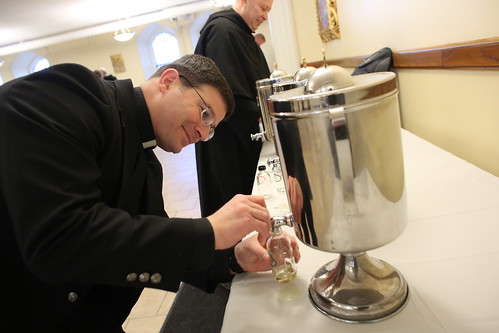
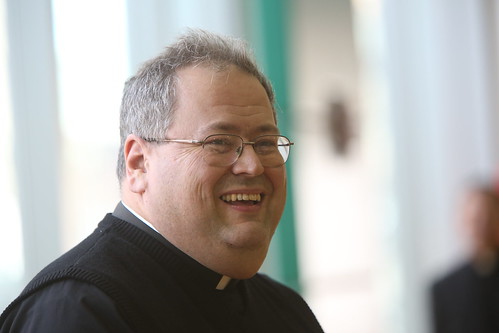

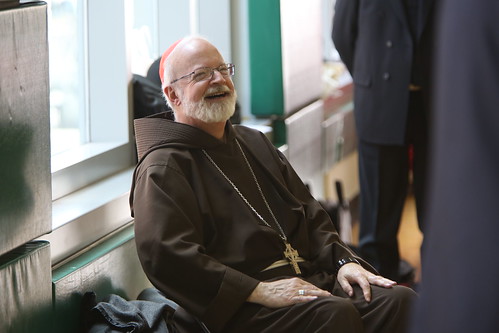
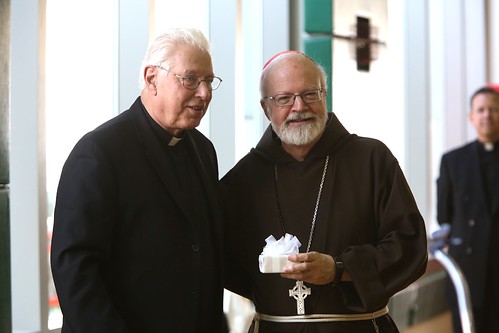

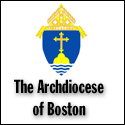



March 26, 2013 at 4:44 pm
The pictures are great! Congratulations, Cardinal Sean. We are all so proud of you.